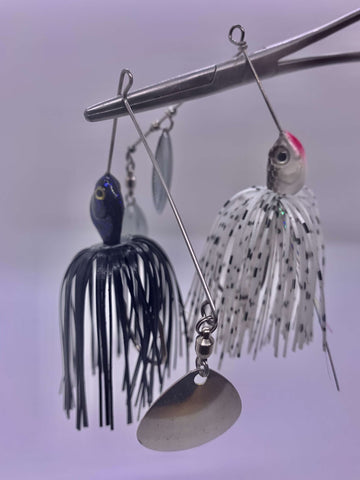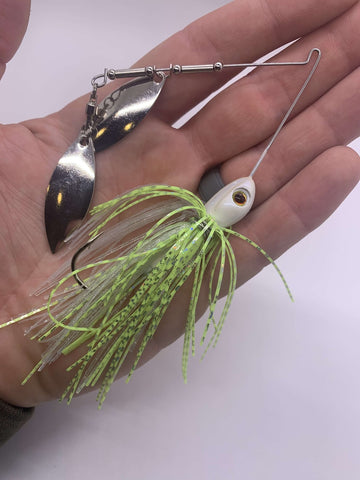Spinnerbaits go all the way back to the early days of bass angling as a sport. These wired lures contain a spinner blade attached to an overhead wire with a skirted lead head jig below to trick bass into thinking it’s a tasty bait fish.
With the onset of bladed jigs and swim jigs, this classic fish catcher has been somewhat forgotten in recent years, but that doesn’t mean it’s any less effective.
In this piece, we’ll take a look at a few of the more common variations of the lure, and when and where to throw them.
The Single Colorado Blade Spinnerbait

This version is the classic spinnerbait model and definitely still has a place in every bass fisherman’s arsenal. The Colorado blade is a large tear-dropped shape with a deep cup in the blade. This blade excels when you’re looking for high vibration to trigger strikes.
We generally like to run a Colorado blade when the water is cold or dirty in order to allow bass to easily home in on the lure from a distance using their lateral lines.
When the water first starts to warm in the spring, bass become increasingly active in feeding up on baitfish in order to fatten up for the rigors of the upcoming spawn. Despite the increasing water temperature, fish still are a bit lethargic as the water temps tend to be in the upper 40’s to low 50’s.
This is where the “thump” of a single Colorado blade spinnerbait really shines. This vibration triggers the bass below into a reaction strike. The single blade spinnerbait is ideally slow-rolled around wood, rip rap, and large grass flats where bass pull up to soak up the sun’s rays.
As far as colors go, you’re going to want to match your blade and skirt color to not only the forage present in the lake, but also to the water color and conditions.
We like to use white or chartreuse with a silver blade when the water is clear, and a dark skirt with a gold or black blade when the water is more stained or muddy. The light colors imitate a skittering baitfish in clear conditions and the darker versions present a great silhouette in low light conditions allowing the bass to see it.
The Double Willow Leaf Blade Spinnerbait

The double willow leaf blade spinnerbait is probably the most commonly used spinnerbait in seasoned bass anglers’ arsenals.
Like the name implies, this blade is long and skinny and comes to a sharp point, and closely resembles a leaf from the willow tree. The cup is not extremely deep, so it doesn’t emit a ton of vibration, but very closely matches the profile and sound of a baitfish swimming through the water. Blade size should also be considered, using smaller blades for minnows and bigger when trying to imitate larger baitfish like shad or herring.
This bait can shine in all times of the year due to its uncanny ability to mimic a small school of baitfish. In the spring when the water has warmed up to the upper 50’s and low 60’s, it can be thrown around pre-spawn staging areas like points and ditches with good success. In the summer all the way through the winter months, the bait is great to fish around schooling fish, wood, rip rap, and anywhere bass are feeding on shad, shiners, or herring. It’s extremely versatile and can be fished slow or fast depending on the mood of the bass.
When picking out colors, you’ll want to stick with one that matches the bait in your lake. White, chartreuse, and silver are great minnow imitators. On lakes where the bass like to eat small panfish like bluegill and perch, you can use a green pumpkin or watermelon colored skirt matched with gold blades to put bass in the boat. Be mindful of the forage and you can easily match just about any baitfish that a bass eats with the willow leaf spinnerbait.
The Indiana Blade Spinnerbait

The Indiana blade spinnerbait is what we’d consider to be the ultimate “tweener”. This blade is longer than a Colorado but not quite as long as a Willow blade. The end of the blade is rounded like a Colorado, but the cup of the blade isn’t quite as deep. This blade is not quite as noisy as a Colorado blade in terms of vibration, but definitely is less stealthy than a Willow Leaf.
This spinnerbait is ideal for conditions that don’t necessarily require high vibration to trigger a strike, but you’d like a little more thump than you get from the willow leaf blade. This lure is highly effective in the late spring and summer months around baitfish eaters, but when the water has a slight tinge or is dirty from recent rains. Paired with colors similar to what you’d use on a double willow leaf blade, white and chartreuse excel, but you should match the hatch in your lake. Again, we like silver blades in cleaner water and gold when it’s more stained.
This bait can be fished in many of the same areas that you’d fish any spinnerbait including rock, wood, and weeds. Retrieve speed with the Indiana blade spinnerbait tends to be steady medium pace to a slower paced retrieve. This allows the bait to run true and also keeps it at a nice cadence so the bass can locate and strike the lure with ease.
Other Considerations

While we’ve touched on the basics of spinnerbait fishing, the aforementioned tactics aren’t rules that aren’t made to be broken. Some places just have quirks that allow you to throw some more off the wall variations of the old bass catching machine.
For example, if you’re in the northern part of the country, you might want to consider throwing a chartreuse or white spinnerbait with matching white or chartreuse blades if you are targeting clear water smallmouth. Similarly, a big gaudy black spinnerbait with a huge Colorado blade can be a money maker in a reservoir creek where the water looks more like chocolate milk or when fishing at night. You just have to be willing to experiment.

In addition to picking the right color and blade combo, selecting a quality spinnerbait is of utmost importance. While you can certainly catch fish on any old spinnerbait that’s hanging on the $0.99 rack at your local bait shop, you’re far better of spending a bit more money on a spinnerbait with quality components. This means a strong wire that won’t break on a big bass, quality swivels, polished blades that won’t rust, a skirt that doesn’t fall apart and a good sharp hook. There is nothing worse than spending the whole day looking for a big bass only to watch your prize catch swim away because of an equipment failure.
Sometimes conditions call for a trailer on your spinnerbait to give it a little extra flair or possibly a little more beef to make it appear bigger in the water. You can use a curly tail grub or a small soft plastic swimbait to achieve this. This will give the hook side of the spinnerbait a little more action that could be needed to trigger stingy fish into biting. The trailer should reasonably match the skirt in color, or you can use a white with chartreuse or chartreuse with white to allow bass something to target when striking the lure. Adding the bulk can also push a little more water and add a bit of vibration that can trigger a reaction strike.

Finally, we’ll talk about the stubborn bass that slaps at the bait, missing the hook. Often bass will follow a spinnerbait, nipping at the tail of the skirt or trailer. You’ll feel the tick of the bite, but you’ll continuously miss these fish. This is where a good trailer hook comes in. A trailer hook is a large straight shank hook with a big eye that you attach to the main hook of the spinnerbait. This is generally fastened to the spinnerbait with some sort of rubber stopper to prevent it from sliding off the spinnerbait when casting or fighting a fish. When a bass nips at the back end of the skirt, they are met with the trailer hook and their luck runs out. A trailer hook has saved many a bass anglers day when the fish are just a bit finnicky.
Conclusion
Spinnerbaits are excellent fish catching tools, but there isn’t always a one size fits all approach to fishing them. Conditions, water temperature, and temperament of the fish all need to be considered when selecting the right spinnerbait. Being aware of your surroundings and letting the fish tell you what they want is an excellent approach to selecting the right one for the day. They are pretty easy to fish, so whether you’re a budding angler or a seasoned vet, a spinnerbait is a great choice to catch bass day in and day out on the water.
Sources:
https://www.fieldandstream.com/how-to-pick-best-spinnerbait-blade-for-bass-in-any-conditions/
https://www.bassmaster.com/tips/spinnerbaits-blades-thing
https://monsterbass.com/collections/baits/products/slingbladez-spinnerbait
https://monsterbass.com/blogs/fishing-tips/best-prespawn-bass-baits
← Older Post Newer Post →


